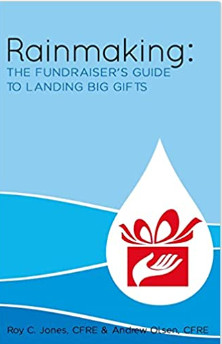by Andrew Olsen, CFRE
Well, that’s not really a question my two-year-old daughter asked me. But it is a question that, over the last few months, a number of nonprofit development professionals and C-level executives have asked.
Interestingly, each person has shared a story about the frustrations they’re experiencing because of the Chinese wall that typically separates annual giving (i.e., direct mail, telemarketing, online giving, events, monthly giving) and major donor programs in their shops, and the angst that this causes. I’ve been surprised to hear that in many cases there is literally a belief that annual giving donors “belong” to the annual giving department, and that major donors are believed not to come from this pipeline. Instead the assumption is that major donors must come from contacts with other wealthy individuals, be they existing major donors, board members, etc. And because of this, relations inside many nonprofits are strained, and opportunities for increased revenue are missed.
Here’s why I think these problems persist . . .
Incorrect belief that major donors don’t “come up” through your annual fund program.
There’s a school of thought in the sector that suggests that major donors don’t come from within your existing annual giving programs. The logic would follow that if major donors don’t come from your annual giving program, why would you ever try to migrate donors from the annual giving program to anything else. Right?
Wrong.
I’m not certain where this school of thought began, but the data I’ve seen doesn’t support it. I’m not saying that all major donors come from within your existing file. Certainly your board members and other influential friends of your organization can introduce you to wealthy people who might have an interest in making a major contribution to your cause. However, gifts like this will be the exception, not the rule.
In his article, Is the Fundraising Pyramid Really a Lie?, Lawrence Henze, Managing Director at Target Analytics, explores this concept and provides an analysis of what Target Analytics has learned on the topic, and why you should in fact look to the existing donors on your file as potential major donors.
I’d also point you to two additional articles that would support this position. Using Your Database to Develop Major Donors, by Susan P. Orr, Founder & CEO of Telosa Software, and Major Gifts and the Internet – An Untapped Opportunity, by Vinay Baghat, Founder & Chief Strategy Officer at Convio both speak directly to this issue.
Compartmentalized fundraising programs
The second reason that I believe these frustrations surrounding major gifts come into play is that in many nonprofit development departments, the different fundraising programs are compartmentalized. Oftentimes the annual giving and major/planned giving departments are even directed by different people on the organization’s leadership team.
Rather than fostering collaboration and an atmosphere that promotes fully engaging donors to accomplish your organization’s mission, this compartmentalization instead fosters an environment of competition that often results in one group or another hoarding donors (and income).
These internal conflicts result in lost opportunities.
Donors lose out on the opportunity to make more significant impacts on a cause they’re passionate about. Your clients lose out on the opportunities that would have otherwise been created by greater donor investment. And your organization loses out because you’re working against each other to accomplish individual performance objectives rather than working together to maximize the impact you can have in your community.
How do we fix it?
First, throw aside your assumptions – assumptions of where your major donors come from and how your fundraising program should operate. Instead, follow the data. Look to your fundraising database and work with your annual giving and major gifts team to identify current donors who have the potential and the likelihood to make a larger impact on your organization. Then devise strategies for engaging these donors and motivating them to become more involved.
And second – learn to share. If you want collaboration and the benefits that come from it, you’ve got to approach your donor base and the funds that will be raised as belonging to your customers (or clients), and your shareholders (the donors). They don’t belong to the corporation (you). This may be tough to implement because you’re still going to need to measure your staff for the purposes of performance evaluations – and you can do that under a model like this. But you can also shift the focus and approach so that it’s a team-based effort and not an every person for herself mentality.

